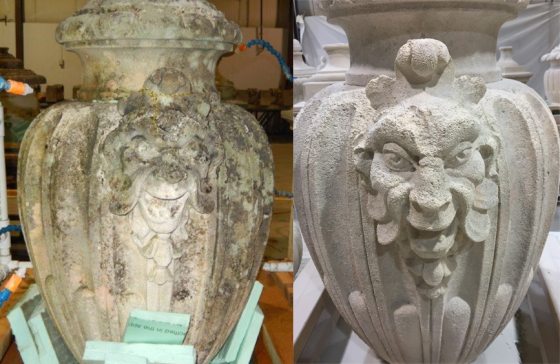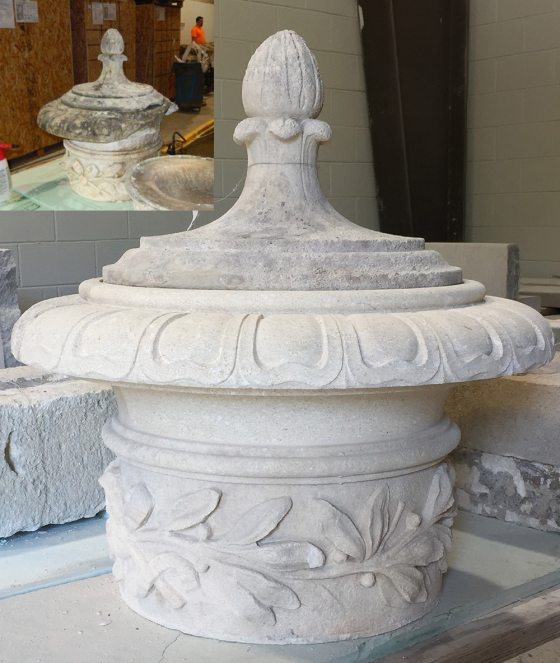What are the components of a grand fountain garden? Dazzling water effects powered by hydraulic calculations, an inspiring design, and a stunning landscape are all parts of an unforgettable scene. For Longwood Gardens’ Main Fountain Garden (along with many other gardens built in the European tradition), sculpture is key to the Garden’s character, lending a unique and intimate quality. Each hand-carved stone is one-of-a-kind and tells a story of both the designer’s aesthetic as well as the artisan’s hand.
As our Fountain Revitalization Project progresses, our trusted partners at Dan Lepore & Sons are the stewards of these cherished objects—cataloging, cleaning, conserving, and repairing more than 4,000 individual artifacts that will all eventually be returned to the Garden. This monumental task, like so many other components of the Fountain Revitalization, combines traditional craftsmanship with the latest advances in conservation and project management.
The work began in the fall of 2014, with the delicate project of removing the stonework from the Garden. Twenty-five masons dedicated approximately 16,000 hours to the painstaking task of dismantling the already-crumbling Italian and Indiana limestone.

As the stone was packed and crated away, the experts at Lepore tagged individual pieces with a designated name and each crate with a QR code tracking system. This system monitors the stone’s location and its progress in the restoration process. The codes also link to an entire catalog of data on each piece, including photos, measurements, diagrams made during an on-site survey, an individualized “prescription” that details the specific work to be performed, and a re-installation schematic ensuring that every element is returned to its precise location.
The first step in the conservation process is to clean the stone with a very fine water mist that removes surface dirt, followed by a micro-abrasive spray that permeates the stone without damaging the material or causing additional erosion. Next an anti-microbial solution is applied, penetrating even more deeply into the pores and dissolving any bacteria that may continue to weaken and damage the stone.

Next comes repairs. Depending on the needs of the individual piece, conservators choose from cementitious patching, pinned crack repairs, stone Dutchmen (hand-carved limestone pieces that replace damaged sections), and full stone replacements. As a final step, the urns are treated with a material called a consolidant that strengthens and protects the stone to help guard against future damage.


The Italian limestone sculptures of the Main Fountain Garden were designed and carved by A. Olivotti & Co. of Florence, Italy, in the early 1930s. Longwood’s founder, Pierre S. du Pont, exchanged letters and drawings with Alessandro Olivotti and his chief designer and sculptor, Piero Morseletto. Eventually Signor Morseletto visited Mr. du Pont at Longwood to finalize the designs, which he took back to Italy for production. Throughout the early 1930s, workers at Longwood Gardens were busy unpacking large crates filled with vases, pedestals, urns, masks, spouts, balustrades, panels, bouquets, and statues—all shipped from the Italian workshops of A. Olivotti & Co.

In addition to intricately carved Italian limestone, the limestone blocks, facings, copings, and other plain pieces throughout the Garden were quarried from domestic sources, and will also be restored as part of the Revitalization Project.
When the Main Fountain Garden re-opens in 2017, yearly maintenance will be required to keep the limestone sculptures clean, and periodic repairs (approximately every 5-10 years) may be necessar


